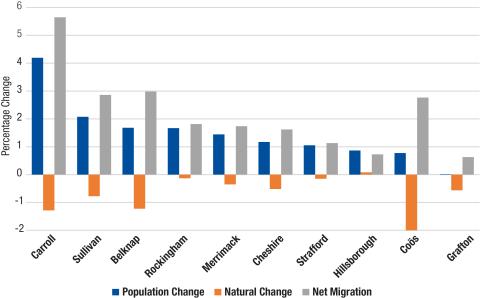Key Findings

The population of New Hampshire grew by 17,700 (1.3 percent) to 1,395,000 between April 2020, when the 2020 Census was conducted, and July 2022, according to new Census Bureau estimates. These population gains were widespread, occurring in each of the state’s ten counties. In contrast, only 52 percent of the nation’s counties gained population during the period. Such widespread population gains are surprising given that deaths exceeded births in nine of New Hampshire’s ten counties, resulting in 4,100 more deaths than births statewide. Only Hillsborough County had slightly more births than deaths (0.1 percent) over the 27-month period (Figure 1). Covid certainly contributed to this loss, but annual deaths already exceeded births in the state before the pandemic. New Hampshire’s entire population gain accrued because 21,600 more people moved to the state than left it. Most of these migrants came from within the United States, but the state also received a significant number of immigrants. Each of the state’s ten counties gained migrants. The largest migration gain (5.7 percent) was in Carroll County, which has long attracted recreational and amenity migrants, including many from large urban areas. These recent data underscore the continuing importance of migration to the state’s future. Such migration gains result both from attracting migrants to the state and retaining the state’s existing residents.

Note: This analysis is based on population estimates released 3/30/23. Readers should recognize that although the Bureau uses the best data and algorithms available at the time of release to generate the data, they remain estimates. Analysis: K.M. Johnson, Carsey School, University of New Hampshire. Source: U.S. Census Bureau Population Estimates.

Kenneth M. Johnson is senior demographer at the Carsey School of Public Policy, professor of sociology at the University of New Hampshire, and an Andrew Carnegie Fellow. His research was supported by the NH Agricultural Experiment Station through joint funding from the USDA National Institute of Food and Agriculture (under Hatch-Multistate project W5001, award number 7003437) and the state of New Hampshire. The opinions are his and not those of the sponsoring organizations.